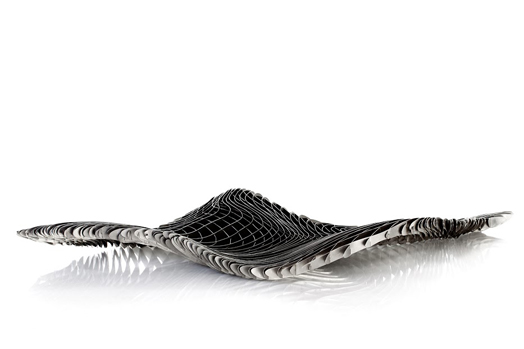By Savitha Hira
Photography: Sumedh
Prasad; courtesy Orproject
Ar. Rajat Sodhi
of Orproject applies anisotropic geometry to develop limited edition lifestyle
accessories for Art d'Inox...
Last week, we
spoke of Computer Aided Technology and building design. Taking the conversation
forward, we had an interesting chat with Ar. Rajat Sodhi, who is continually in
research mode, developing his repertoire and skill set.
 |
| The Bowl |
His research
with distorted geometry and material strength led him to explore how the
thinnest of surfaces could be made structurally stronger, when bent into form;
and how force acts upon the bent form to test its tenacity at various
points. Playing with steel as a medium
of his analysis, and capitalizing on its properties of elasticity and
weightlessness, Rajat has used a ½ mm (half millimeter) thin steel sheet to
arrive at two unique forms - a vase and a bowl.
As versatile with
software codes, as he is with design, Rajat developed an algorithm based on the
curvature of the surface and on developing several curved strips that could be
notched together to build a sturdy form. Once the paper model was finalized with the
design morphed and calculated to digital perfection, the steel proto was
actualized.
“Anisotropic material aggregations develop geometries, which form networks, surfaces and volumes based on single curved metal sheets,” explains Rajat. “Digitally calculated as material deformations of force-based vector fields, the morphologies create dense and open distributions of the steel strips that distort and form curved volumes. Both, the vase and bowl are made up of undulating layers of stainless steel, which meet and connect at varying intervals. This system creates a space-enclosing volume, which nestles around the core of the vase or the objects to be placed on the bowl. As a result, the opacities and translucencies of the objects deviate and generate continuously flowing geometries.”
Christened the
Umami series (after the Japanese senses of smell and taste - vase and bowl),
these limited edition prototypes could well be the start to envisaging large
span structures as say, the roof of a building, touching a plane as the bowl does, at 3 different points; or the geometry of the vase could well be translated
into the skin or façade of a towering skyscraper! The added advantage here, as
the creative designer explains, would be to regulate climatic conditions, as
the vase, when viewed in one direction appears opaque, whilst in another,
appears clear; translated into building design, this could offer North-South
open spaces while restricting the generally lesser desirable East-West axis.
For more
information / purchase of the Umami limited edition designer pieces, please
write in to: info@orproject.com

.jpg)
.jpg)
.jpg)
.gif)
Very interesting applications.
ReplyDelete